Cerebral Palsy:
Cerebral Palsy (CP) is a term used to describe a group of chronic conditions affecting body movements and muscle coordination. The four main categories include:
1. Spastic CP
2. Athetoid or Dyskinetic CP
3. Ataxic CP and
4. Mixed CP

This project was brought up by NJDC team (National Job Development Center, Chembur) because it was felt that there is a need to solve a lot of issues concerned with their spastic students working on the computer workstation.
The spastic subjects working on the computer cannot sit in the prescribed postures as followed by the normal people based on ergonomics principle. This unintentional awkward posture in turn can cause a lot of other musculo‐skeletal problems to them, which may further attenuate their muscle tone.

Aim:
To design an ergonomically efficient workstation, which the spastic person can adjust by himself to sit comfortably while working on computer.
The project 'Computer Workstation Design for Cerebral Palsy Children' basically deals with the problems of Cerebral Palsy people while using the existing computer workstation. It includes designing of an ergonomic workstation, which will help the Cerebral Palsy people to work on computer workstation efficiently.
A proper design approach was followed which included determining different ergonomics related issues like body dimensions, biomechanics, behavior, safety etc. of the users with reference to the neuromuscular difficulties and applying those observations in designing a computer workstation for the CP. The later part of the project also describes different concepts that were evolved for these individuals along with the final concept.
The final concept designed makes use of very simple and automatic mechanisms which help the spastic person to adjust the chair, the monitor table and the keyboard table height efficiently.
Case Study Downloads:
• Computer Workstation Design for Cerebral Palsy Children - Pdf


